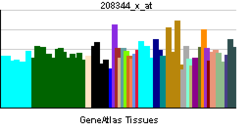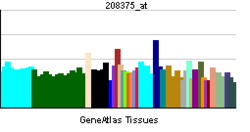IFNA1
n/a
n/a
n/a
n/a
n/a
Interferon alpha-1/13 is a protein that in humans is encoded by the IFNA1 gene.
Leukocyte interferon is produced predominantly by B lymphocytes. Immune interferon ( IFN-gamma; MIM 147570) is produced by mitogen- or antigen-stimulated T lymphocytes.[supplied by OMIM]
The interferons (IFN)s are a family of cytokines with potent antiviral, antiproliferative and immunomodulatory properties. IFNs were originally discovered as molecules that could reduce the ability of a normal virus to infect cells, a process called viral 'interference'. IFNs have been classified into two major types of IFNs, type I and type II, based on their interactions to a specific cell surface receptor. In recent years, a novel class of cytokines with IFN-like activities has been described and designated as type III IFNs (IFN-λ1-3). In humans, there are 13 different IFN-alpha genes, designated as IFN-α1, -α2, - α4, - α5, - α6, - α7, - α8, - α10, - α13, - α14, - α16, - α17 and - α21, and one each of the IFN beta (IFNB), IFN-Epsilon, IFN-Kappa and IFN-Omega genes. The human IFNA gene family shares 70-80% amino acid sequence homology, and about 35% identity with IFNB. The high degree of amino-acid sequence similarity within the IFNA genes suggests a common ancestor gene. It seems likely that the IFNA gene cluster has been generated by gene conversion or recent duplication events. There are 12 functional human IFNA gene products. All of these IFN-α proteins exhibit high homology in their primary, secondary, and tertiary structures. IFNA and IFNB are produced by a wide range of cells such as macrophages, fibroblasts and endothelial cells, but plasmacytoid dendritic cells (pDCs) are considered the main producers of IFNA in response to RNA or DNA viruses or nucleic acid-containing immune complexes.
...
Wikipedia


